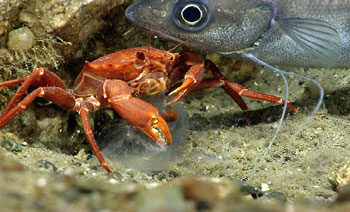NMFS Approves “Majority” of Council’s Habitat Amendment

Hake and red crab along the slope between Heezen and Nygren Canyons. 2013 Northeast U.S. Canyons Expedition image
NOAA’s National Marine Fisheries Service (NMFS) has approved –with two exceptions – the New England Fishery Management Council’s Omnibus Essential Fish Habitat Amendment 2 (OHA2), paving the way for sweeping change to the existing network of closed and management areas in the Gulf of Maine, Southern New England, and Georges Bank. The changes will provide better protection for both fish and habitat while eliminating closures that no longer serve their intended purpose. The final rule implementing the new regulations will not be published until later this winter, but NMFS informed the Council on January 3 of its decision to approve “the majority” of the amendment, which sets the stage for what’s to come.
Two of the Council’s proposed habitat management areas (HMAs) were disapproved:
• Cox Ledge in Southern New England; and
• Eastern Georges Bank, which called for the removal of Closed Area II as currently configured, replacing it with new management areas that would have allowed fishermen to access the abundant scallop resource on the Northern Edge.
Council Executive Director Tom Nies said, “Naturally we’re disappointed that our proposed Closed Area II changes were not approved, but the fact that the vast majority of the amendment will be implemented is a solid endorsement of the work the Council and staff did to dramatically change the closure system off New England.”
As for the disapproved measures, Nies said, “We’ll be discussing NMFS’s comments at our late-January meeting, and the Council may decide it wants to revisit these issues going forward.”
The habitat amendment has five key purposes, which are to: (A) designate essential fish habitat (EFH) by lifestage for each species managed by the Council; (B) minimize the adverse effects of fishing on EFH to the extent practicable –a monumental undertaking that took years to carry out using the state-of-the-art Swept Area Seabed Impact model known as SASI; (C) identify other actions to encourage conservation and enhancement of habitat; (D) improve protection of habitats on which juvenile groundfish depend; and (E) improve protection of spawning groundfish.
The Council used six types of management approaches to achieve these purposes: (1) the EFH designations; (2) Habitat Areas of Particular Concern (HAPCs); (3) Habitat Management Areas; (4) Spawning Management Areas; (5) Dedicated Habitat Research Areas; and (6) changes to approaches involving framework adjustments and monitoring.
NMFS approved:
• All of the Council’s EFH designations;
• All of the HAPC designations, including: (a) the two existing ones for Atlantic Salmon and Northern Edge Juvenile Cod, (b) four new ones called Inshore Juvenile Cod HAPC, Great South Channel Juvenile Cod HAPC, Cashes Ledge HAPC, and Jeffreys Ledge/Stellwagen Bank HAPC, (c) 11 deep-sea canyons, and (d) two offshore seamounts;
• Most of the Habitat Management Area measures, including: (a) establishing new HMAs in Eastern Maine and on Fippennies Ledge where mobile bottom-tending gear is prohibited, (b) maintaining the Cashes Ledge Groundfish Closure Area with current restrictions and exemptions, (c) modifying both the Cashes Ledge and Jeffreys Ledge Habitat Closure Areas, which are closed to mobile bottom-tending gear, (d) prohibiting all fishing gear except lobster pots in the Ammen Rock Area, (e) maintaining the Western Gulf of Maine (WGOM) Habitat Closure Area, which is closed to mobile bottom-tending gear, (f) aligning the boundaries of the WGOM Groundfish Closure Area to match the WGOM Habitat Closure Area, (g) exempting shrimp trawling from the northwest corner of the WGOM areas, and (g) identifying the existing Gulf of Maine Roller Gear restriction as a habitat protection measure.
Also related to Habitat Management Areas, NMFS approved the Council’s proposals to open up prime scallop fishing bottom in Closed Area I and the western portion of the Nantucket Lightship Area. In short, the current Closed Area I Habitat and Groundfish Closure Area designations will be removed, as will the Nantucket Lightship Habitat and Groundfish Closure designations.
Instead of keeping these less-effective habitat/groundfish areas in place, the Council established a Great South Channel HMA, which will be closed to: (1) mobile bottom-tending gear throughout the area; and (2) clam dredge gear in the northeast section (see map on page 1). NOTE: Clam dredge gear will be allowed throughout other parts of the area for one year while the Council considers refinements through a Clam Dredge Framework, which is under development. OHA2 also created a new research area for Georges.
Learn more about how the Closed Area I and Nantucket Lightship actions will be impacting scallopers at: http://s3.amazonaws.com/nefmc.org/NEFMC-Scallop-FW-29-Advances-Following-Habitat-Decision.pdf.
Two new Dedicated Habitat Research Areas(DHRAs) will be established through this habitat amendment as well, each with a three-year sunset provision. One is on Stellwagen Bank within the Western Gulf of Maine Closure Area, and the second is on Georges Bank in what is the current Closed Area I South Habitat Closure Area. These areas will be the focus of coordinated research to improve understanding of the ecological effects of fishing across a range of habitats and, ultimately improve model forecasts. The Council identified a set of priority research questions that the DHRAs should address. The questions are based on four broad focus areas: (1) gear impacts; (2) habitat recovery; (3) natural disturbance; and (4) productivity.
Questions? Contact Michelle Bachman, the Council’s habitat coordinator, at (978) 465-0492 ext. 120; mbachman@nefmc.org.
